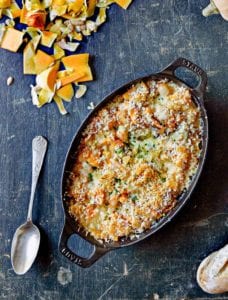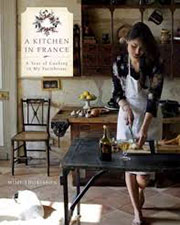
Butternut squash gratin. It’s a simple yet underheralded approach to consuming everyone’s favorite fall vegetable. Think butter. Bread crumbs. Cream. Cheese. And, oh yeah, butternut squash. This, dear reader, is what we refer to as stealthy healthy. And as much as we appreciate this scalloped casserole approach with just about anything, quite honestly, we particularly love it with roast turkey. After all, ’tis the season.–Renee Schettler Rossi

Butternut Squash Gratin
Ingredients
- 3 tablespoons unsalted butter, plus more for the baking dish
- 1 large onion, thinly sliced
- 1 garlic clove, thinly sliced
- 1 1/2 pounds (about 1 large) butternut squash, peeled, halved lengthwise, seeded, and thinly sliced between 1/8 and 1/4 inch thick
- 1/4 teaspoon grated nutmeg
- Fine sea salt and freshly ground black pepper
- 1/2 cup heavy cream
- 3/4 cup fresh bread crumbs
- 3/4 cup grated Comté cheese
- A few chives, finely chopped (optional)
Instructions
- Preheat the oven to 350°F (180°C). Butter a 10-inch (25-centimeter) baking dish.
- In a large sauté pan or Dutch oven, heat 2 tablespoons butter over medium heat. Add the onion and garlic and cook until softened and translucent, 4 minutes.
- Add the butternut squash slices and nutmeg and cook, stirring occasionally, until slightly tender, 5 to 8 minutes. Season with salt and pepper to taste.
- Transfer the squash mixture to the baking dish. Smother with the cream, sprinkle with the bread crumbs, scatter the cheese on top, and dot with the remaining 1 tablespoon butter, cut into pieces.
- Bake until the surface is golden and bubbly and the butternut squash is tender, 30 to 40 minutes. Serve immediately, sprinkled with the chives, if desired.

Explore More with AI
Nutrition
Nutrition information is automatically calculated, so should only be used as an approximation.
Recipe Testers’ Reviews
This is one of the best things I’ve EVER made. No exaggeration. I love EVERYTHING about this butternut squash gratin recipe. You will, too. When you taste it, you will instantly be transported to the holidays. Nature’s candy and Gruyère. It tastes like Thanksgiving!
This recipe is so straightforward. Like hearing the PERFECT song (that would be “Crazy” from Patsy Cline) can set the tone for your day, this PERFECT side dish can do EXACTLY that for any meal.
I made this butternut squash gratin recipe last night, and it’s now on my short list of Thanksgiving and Christmas sides. I just love it. It’s beautiful and delicious, and the directions are clear, concise, and easy to follow. This not only tastes marvelous but it also makes a beautiful presentation. And leftovers reheated in the oven until bubbly are only better. A real winner!
I will definitely be making this butternut squash gratin recipe for Thanksgiving.
The only suggestion I have would be to add some stock or water while the squash is being cooked. The sauté pan is very dry and there is a lot of fond at the bottom which would benefit from deglazing. The liquid would also generate steam in the pan and help the squash cook more quickly.
This is a delicious fall butternut squash gratin, simple and likely to appeal to all.
The recipe directions are clear, concise, and easy to follow. I used the same pan that I sautéed the vegetables in to finish the dish in the oven. It did take a little longer to get the crumbs nice and brown and the gratin bubbly. I think substituting the easier-to-find Swiss cheese for Comté would be fine and I’ll do that next time.
This butternut squash gratin recipe is fantastic—great flavors and easy to make (aside from peeling the squash).
First and foremost, I liked the flavor of this particular mix of ingredients. It was so delicious that everyone had second helpings.
We’re not very big chive fans, and so I might use other herbs, like thyme. I would also switch up the cheese to maybe a mix of cheeses, but this is only because we love all types of cheese.
A gratin is usually thin slices of potato and, because the pieces of potato are so thin, you usually don’t have to stove cook first. Because this is stove-cooked to tenderness before it’s baked in the oven, I think it would be possible to use pre-cut chunks of butternut squash they sell at certain grocery stores. You would not have the elegance of the thin layer but it would avoid the peeling and cutting of the butternut squash.
Let me start by saying that I used an 8-by-11-inch glass baking dish for this butternut squash gratin recipe and by the time my husband and I had finished dinner, 8 by 9 inches of the gratin was gone. It’s that good. It also explains the contented humming coming from my husband as he loaded the dishwasher.
I used my Japanese vegetable slicer to cut the squash. Very time-consuming, but in the end I think the thin, 1/16-inch slices allowed the finished gratin to become soufflé-like. I cut the onions and garlic by hand. I used the shred side of the box grater to grate the cheese. I also took an extra minute to break down some wheat and rye sandwich bread in the food processor for fresh bread crumbs. In the end, this was an amazing variation in fresh crumbs that I highly recommend for this dish. I am a pushover for nutmeg, and every chance I get, I grate the spice fresh on a microplane.
The sautéing went off without a hitch. For the thickness of squash I had, my stovetop cooking took about 7 minutes. I layered the ingredients as described and in about 22 minutes I had a fragrant, bubbling, golden brown gratin. The bread crumbs were so perfectly crunchy that I had to warn my husband if he didn’t cut through the whole gratin and dared scooped just the amazing top layer, we would have words. (He obliged.)
As delicious as the recipe is, I would layer the cream and cheese next go around. Start with a layer of squash, then add 1/4 cup cream and 1/4 cup cheese. Add the rest of the squash, spreading it in a neat top layer. Finish with the remaining 1/4 cup cream, 1/2 cup cheese, and all the bread crumbs. Tada!
This butternut squash gratin recipe was easy and a nice change from scalloped potatoes. It was a creamy, slightly sweet, slightly crunchy, nutty side dish.
Everything came together nicely. I used my largest skillet but it was still a little crowded.
Hearty and comforting, this butternut squash gratin recipe was a winner. The sweetness of the butternut and onion wasn’t overpowered by the cream and cheese, allowing us to fully enjoy the seasonal butternut bounty. The subtle nutmeg was nice, and the crunchy golden bread crumb topping—well, who wouldn’t love that?
I had winter squash enthusiasts as my tasters, so I doubled the recipe to ensure leftovers—a good call! (Also, I had trouble finding a butternut that weighed only 1 1/2 pounds. I got one that was 3 pounds, and it seemed the average size at the market.)
The recipe as-is would fit in a 9- to 10-inch deep-dish pie plate. Doubled, the recipe fit in a standard 9-by-13-inch casserole dish and I simply added 3 to 5 minutes to the sautéing and baking.
If I had not been able to find Comté cheese, I would have used a combination of Gruyére and Emmental.
Don’t have time to make fresh bread crumbs? Got good news for you—dried panko worked just fine. My “thinly sliced” squash was about 1/8 inch thick. It was perfectly cooked without being mushy.
I love this time of year when the variety of squash is abundant. One of my favorites is butternut squash, so I was intrigued by this recipe. The smell of this butternut squash gratin baking was extraordinary! And the flavors were delicious and comforting as well.
What was different about this recipe was the way the squash is sliced before being placed in the casserole to bake—thinly sliced instead of cubed. While intriguing, I found that cutting it this way then trying to sauté it in a large pan caused some issues. It was so filled with ingredients that it was hard to stir everything. I would suggest doing this in a Dutch oven so that the sides are higher and it’s easier to sauté.
I love winter squashes, especially the butternut. Never served it as a gratin before and now it seems so obvious. The recipe is easy to prepare, clear, and makes for a delicious fall side dish. It’s a little sweet, pretty savory, and has a nice range of textures. It might just make it to this year’s Turkey Day dinner.
I cooked the squash closer to 7 minutes to get it softened but definitely still crunchy. After cooking the casserole in the oven, the squash was fully cooked after about 35 minutes but still had some texture that we loved rather than completely mushy.


















I liked the crunchy salty top combined with the tender squash. The squash on its own might be a bit too sweet for my taste. Since I used a small square baking dish, some of my later bites were just of squash. I’d make it again but I might use a bigger baking dish, or slat in crumbs and cheese so the bottom layer gets that savoury goodness as well.
Iris, I hear you on the sweetness of the squash—it can be a bit much on its own. Using a larger baking dish sounds like a smart tweak, and adding crumbs and cheese to the bottom layer is an even better idea. That extra bit of crunch and salt would balance things beautifully. Thanks for sharing your experience!
I don’t like butternut squash, perhaps because when I was growing up it was always brown sugar and butter. Let me tell you, this gratin was so delicious, I’ve made it 2 times in the past week. Shared some leftovers with a some friends who also don’t like butternut squash. They rang me up for the recipe! Knocking it outta the park again, Leite’s never disappoints.
Bbqgoddess, you’ve made my day! Hearing that this gratin turned you—and even your butternut squash-averse friends—into fans is the ultimate compliment. Twice in one week? Now that’s dedication! Thank you for sharing the love (and the recipe) with your friends.
Could I use a mix of sweet potatoe and squash?
M, we didn’t test it that way, so we can’t say how it will turn out. As long as you cut the squash and sweet potato in the same size, it should work fine, though the flavor will be slightly different.